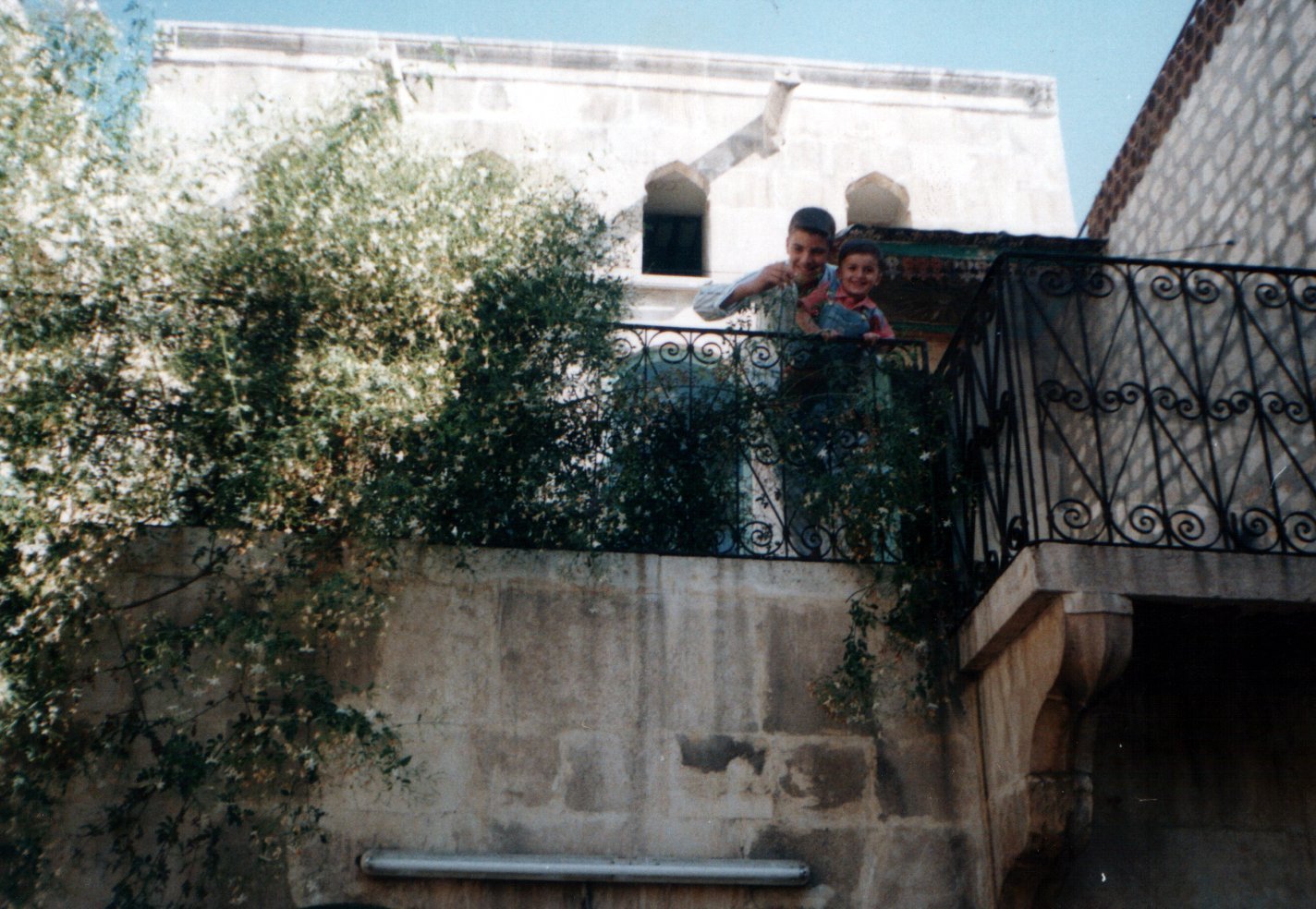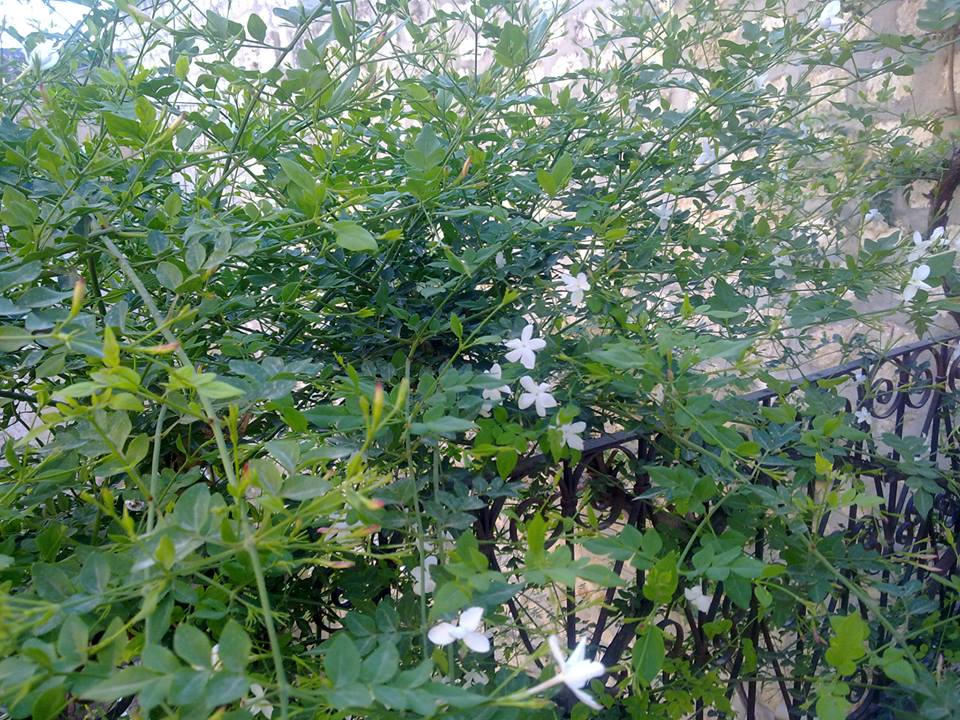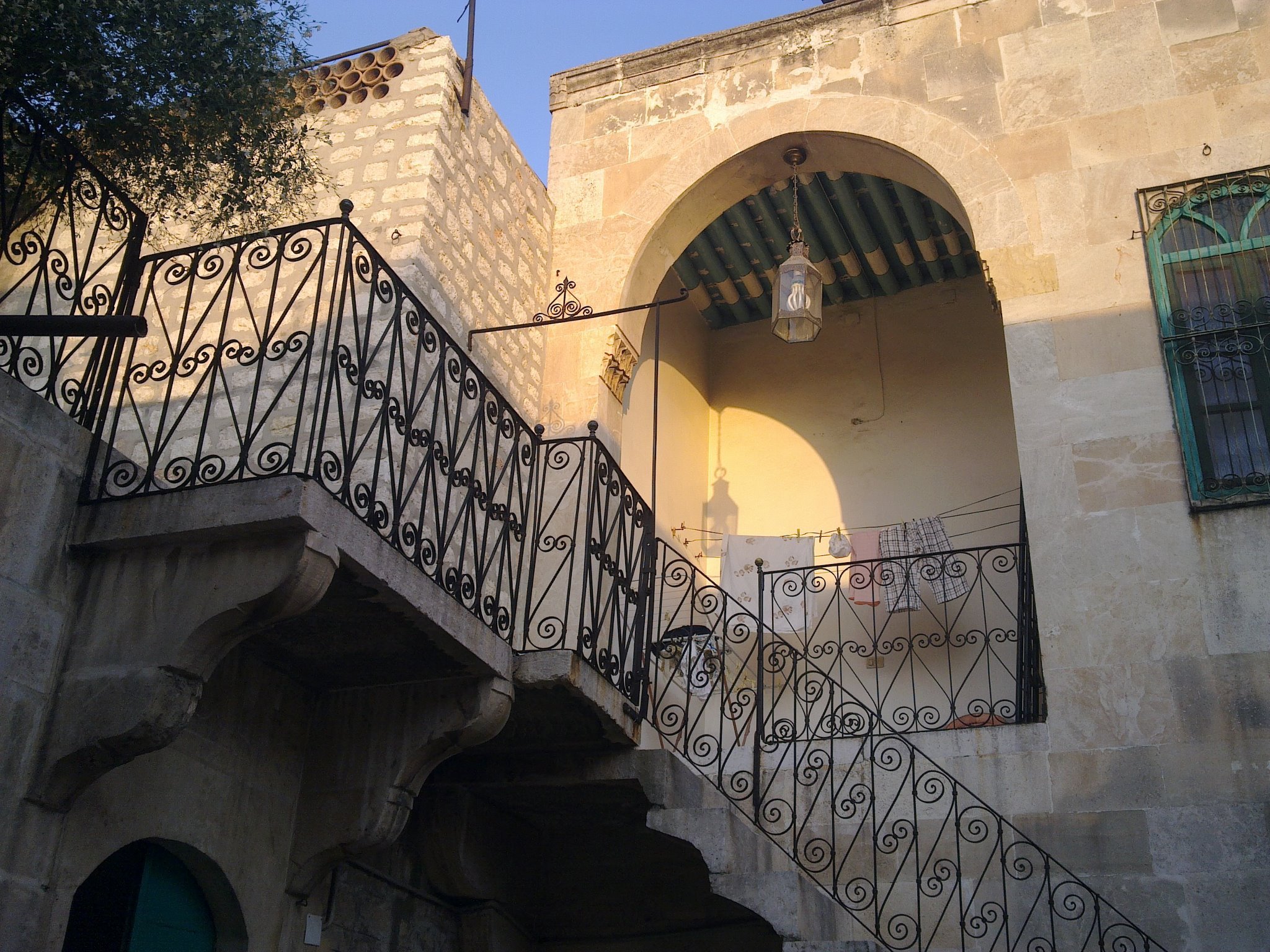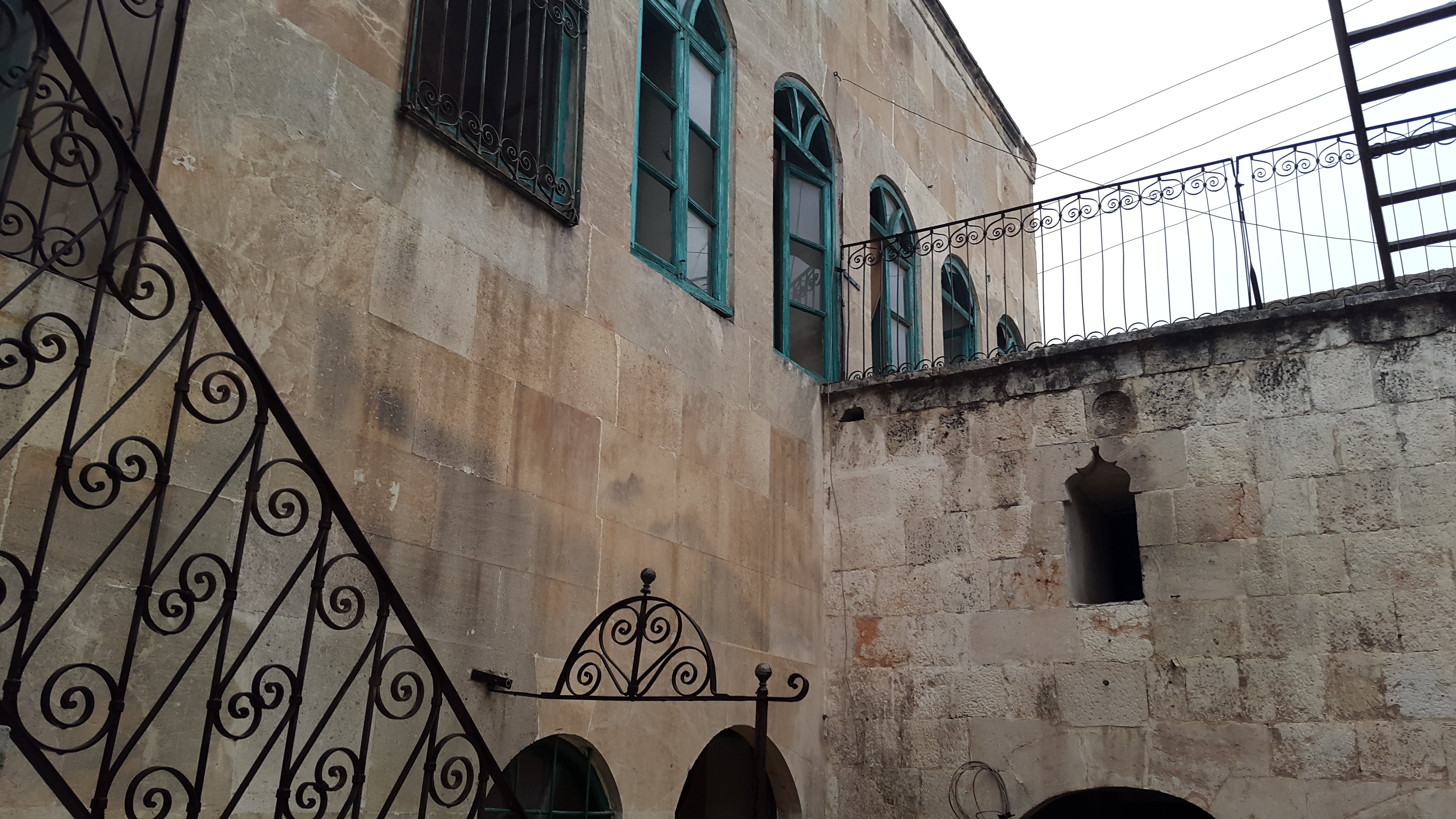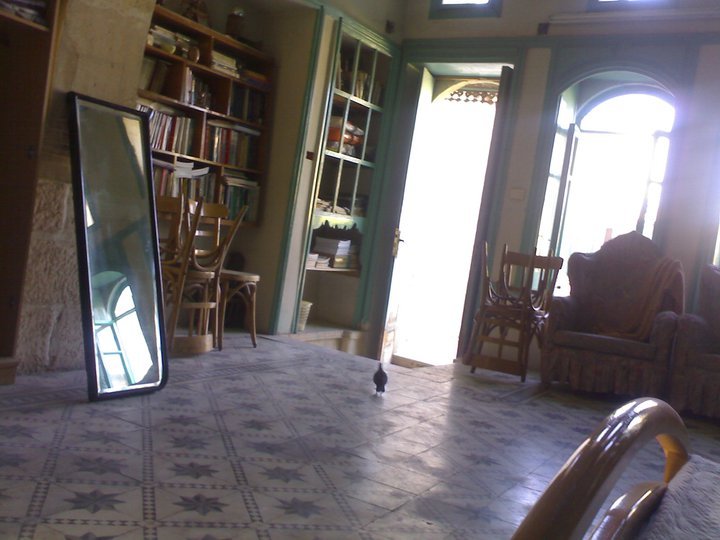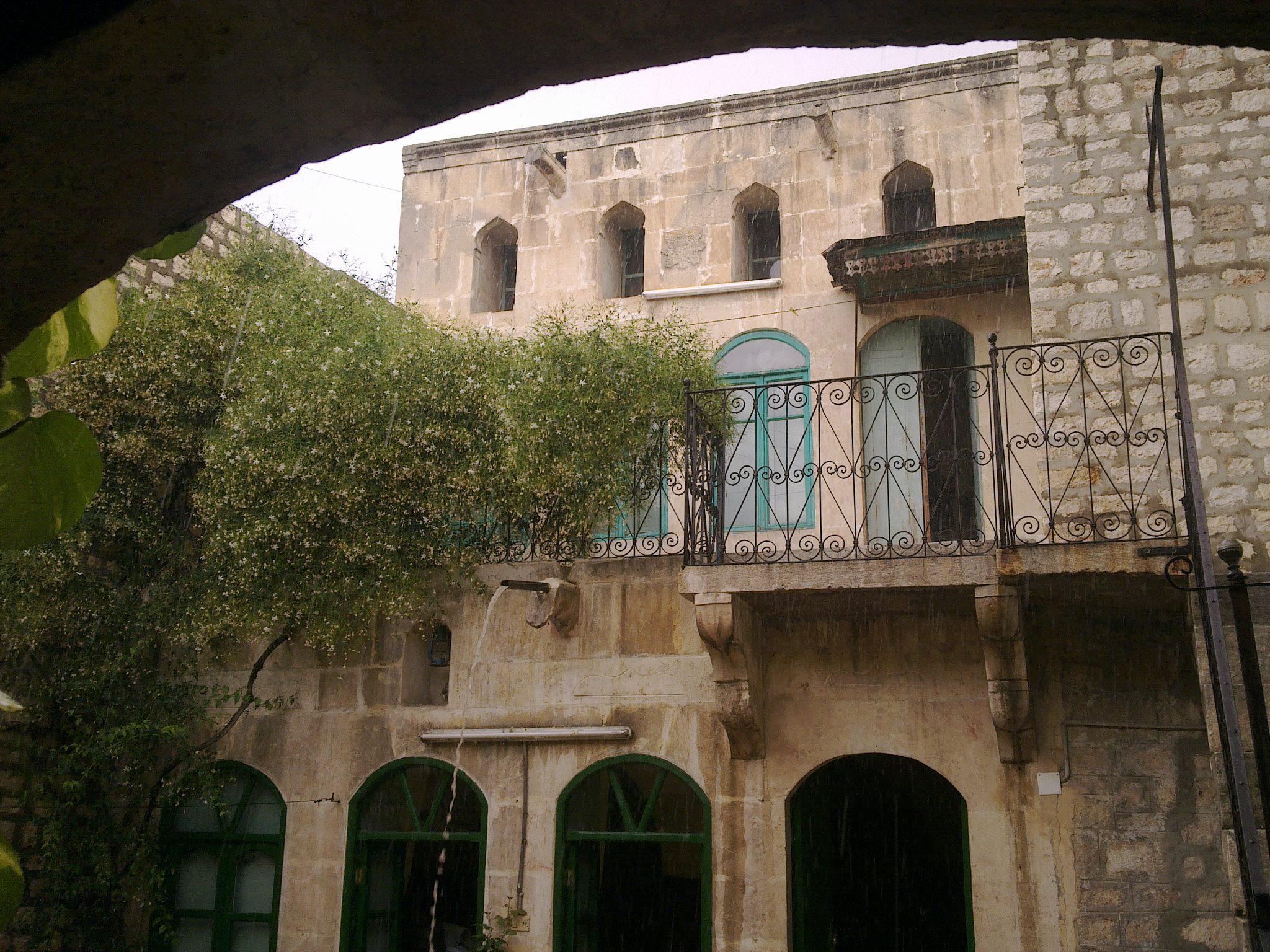When I bought and renovated a house in the Old City of Aleppo, I was asked by the Syrian Engineers Syndicate to assess the experience. I told the cultural committee represented by Mr. Khaldoun Fansa that I would follow an Arab expression that you don’t make a judgment on something for a year and seven months. After that time I gave this lecture to the Syndicate. It has been translated, edited and updated and now also includes the view of two of my children.
I was born in 1950 in what we call an “Arabic house,” a stone building built around a courtyard, sheltered from its neighbors and housing just one family. It was in the Al Bustan area of Aleppo, by the southern gate of the Saray palace and just inside the eastern wall of the old city. We left in 1954 to live in al-Ansari in a house that was similar to an Arabic house in that we lived there alone without neighbors above or below us.
In 1963, my father’s political views on the split from Egypt led to a violent clash between my brother and another man and we were forced to move into my grandfather’s house in front of the Altunbugha Mosque. In 1979, I moved to the United Kingdom to study, living there for six years in houses rather than apartments. It was while I was living in England that I realized how much I loved the culture of Aleppo. This came partly from my father, who had always cared deeply for the heritage of the city and its Islamic history, and from seeing the way that in Britain the past was respected and preserved. Later Syrian television also shaped my desire to live in an Arabic house as many of the dramas shown during Ramadan in the 1980s were set during the Ottoman era or the early days of French rule and they showed people living in these homes.
Apartment living with all its intrusions from neighbors had worn me down so in 1996 I decided to move from a large ground floor flat with a garden in al-Hamdaniyeh to a house in Qadi Askar, on the edge of the Old City. I was looking for somewhere that was private, not over-looked by tall buildings and not too close to anywhere too busy. I wanted to renovate a house that was of historic and architectural significance but that had not been damaged by a poorly thought out renovation. It had to have reasonable access to the rest of the city and be affordable.
Buying in the Old City is a complex process. Ownership is often divided among many heirs and about half of all houses are involved in some sort of dispute among the owners. I was looking for a house that all the owners wanted to sell. Getting a loan was also a problem. Banks won’t lend for houses that have wooden roofs, seeing them as a fire hazard..
After 12 months of looking, through an agent I found a nearly ruined house in a section of the Old City. It was a stone house, possibly dating back to the Mamluk era (1250-1517), with a land area of 205 square metres. It had six rooms, each with six windows looking out on to a courtyard. It was beautiful but in poor shape having last been renovated in 1898. The eastern side where the front door was had cracked and subsided about 10 centimeters. The liwan, the upstairs room that was open on one side, also had cracks in the stone and water was leaking in from the abandoned house next door. But it had not been divided up and nobody had carried out any misguided renovations, meaning that it could be rebuilt in a way that was sensitive to the architecture. Once I had found the house, then the negotiations began with the 18 owners, the children and grandchildren of a deceased previous owner. Fortunately they all wanted to sell but it still took six months before a contract was signed.
The next step was to get a license for renovations. The changes were aimed at shoring up the house and opening it up inside. The front door was relocated to the western side of the house, allowing a new dining room, kitchen and living room and opening up the circulation.
I didn’t change the façade or the courtyard walls in any way so as to preserve the appearance of the house but the interior needed changes to make it more suitable for family life and to bring more light and air into the rooms, particularly in winter. We kept as much of the old woodwork and tiling as possible, only replacing those that were damaged beyond repair. To cut back on fuel oil, we installed solar hot water on the roof. We had hoped to use wood to heat the house in the winter to cut out oil altogether but we lacked the space to store enough firewood and it was too time consuming to stoke the fire all day.
I’d found an excellent stonemason and carpenter but was less happy with the electrician and painter that I hired. The Antiquities Authority was mostly helpful, allowing the realignment of the front door to allow a reconfiguration of the interior. The local council also paved the alley outside the house and painted some walls. The power company was more of a problem as the network in the neighborhood was poor and residents were relying on a single generator.
* * *
They say that you should wait a year and seven months before you pass judgment on a new home. (The saying rhymes in Arabic). For me, moving to the Old City was a special source of happiness, particularly as renovating the home was such a personal achievement. It gave me such pleasure to sit in the courtyard under the large jasmine tree that grows there and have complete privacy. Nobody overlooks us, nobody sees how I’m dressed or how I sit. I could never go back to living in an apartment.
My wife had only agreed to the move if we could go back to an apartment if she hated living there. She was worried that it would be more difficult to keep clean and more work for her but after three months she agreed to go on living in the house. The boys, AlHakam and Karam, were 11 and 9 so for them it was an adventure. My girls, Rama, Lara and Noor, then aged 16, 14 and 12, were much more anxious about the move. They were the only girls in their school who did not wear hijab and they missed their friends from our old neighborhood. In the Old City, there were few places to go for a walk and they felt confined in the house.
Renovating an old house and living in that part of the city was not without difficulties. The infrastructure of the Old City is poor, with water, sewage and power supplies that have not kept up with modern demand. Restrictions on renovations can present problems. If city authorities are to attract more people to renovate and live there, they need to allow interiors to be remodeled for modern life. Toilets have to be moved from kitchens, some interior courtyards need to be covered to allow people to move about without having to go outside and rooms need to be realigned.
The area is densely populated and that can mean a lot of noise. There are 10 mosques near the house and the Muezzins all issue the call to prayer at the same time so that it all merges into an unpleasant noise. You can’t hear the Muezzin with the nicer voices because of the cacophony of them all together. It would be better if they took turns. Weddings would often go on until five in the morning, keeping us all up. Celebratory shooting did not just happen at weddings either but during other parties. Small trucks in the narrow lanes meant a lot of noise in the house.
There were many problems you had to live with if you chose to keep the Old City alive by living there and renovating a house. The city authorities and the organizations that controlled services always treated residents of the area poorly. Water and power cuts were common and the authorities did little to alleviate the problems. Schools were poor but there was no effort to improve them. When the power company did do work in the area, they would not clean up after construction, leaving it to local people to deal with the problems. Public works would start but never be finished. There is very little concern about helping those who live in the Old City.
There were a few mice, and some scorpions we think came from the neighboring house. Also mosquitoes and flies because of the nearby butcher shops. Some nearby abandoned buildings were a source of problems because water ran from them into our house, causing damage to some of the columns. It was impossible to resolve these problems as some buildings had as many as 100 owners and none of them wanted to pay for repairs.
Work on the house never really ended. Old houses need a lot of maintenance and I also liked to improve and repair the building. We took out a fireplace in the living room that proved burdensome to keep alight and sent smoke into the room and the courtyard was repaved to improve drainage. When I found beautifully carved stones I replaced those that had been damaged over the years.
* * *
My family and I lived in the house for 16 years before I had to leave Aleppo. I always felt safe in the house with its privacy and sense of seclusion. We have now been forced to leave. I feel like a failed man because I tried to care about my heritage but ended up losing my home.
My daughter Lara’s memories of the house are tempered by the experience of moving from a relatively liberal, prosperous neighborhood in Aleppo to the much more conservative Old City.
Lara: When we first saw the house before we moved to it, I liked it and felt it was huge. And what contributed to my love for it is that we thought we would be there only in the summer, but we ended up moving there year around. The house is beautiful and full of light and air at that time of the year. Sitting there in the summer under the jasmine is a joy. But it was hard in the winter, when the courtyard, in the center of the house, was filled with rain, although you didn’t need to cross the courtyard except when going to one of the three bedrooms because all of the entrance, living room, dining room, toilet, bathroom, and kitchen were connected internally. Keeping the whole house clean was still a difficult task because you just could not close off the sources of dust.
Now the neighborhood. I did not like the larger district because many people there had double standards about certain issues. Although the majority were conservative in all aspects, there were a few who drank and gambled but whose wives were still expected to dress in black head-to-toe. It wasn’t enough that some men had their wives to control; they used to harass us when we went out as we didn’t wear the hijab. In the whole district, there was only one other family whose women did not wear the hijab, so the people’s lifestyle and expectations put a lot of pressure on us. One shocking incident decided it for us. As my sister was walking to school wearing her decent uniform, one man spat on her because she wasn’t wearing a hijab. We ended up putting it on but I felt that it was coercive. My father gave us complete freedom to decide whether or not to wear the headscarf, but he expected, as per the accepted norms in Syria, that we go on wearing it if we are to ever take it up.
Ten years on, with the start of the Revolution and people’s mobility increasing, many started to live a more liberal life. I was moving between Aleppo and Gaziantep in Turkey, and I liberated myself of the hijab that was imposed on me because of these outmoded traditions.
Of course, not all the neighborhood men were of the type I described. There were examples of chivalrous men, like the ones we hear about in the TV series that featured the old neighborhoods. In our very street, for example, people were nice and caring and men generally respected us and treated us like their sisters.
* * *
My oldest son AlHakam moved to the house when he was 11 and enjoyed helping with the renovation:
AlHakam: My siblings and I have brilliant memories of our spacious flat in the al-Hamdaniyeh district where we were born. It was on the ground floor and had two gardens that my father had revamped. But my younger brother Karam and I were very intrigued by the Arabic house, too. As children who had had no friends or family in the east of the city, including the Old City, the west-east gap was very conspicuous. There were very large architectural and cultural differences. From our first visits there, it was not hard to notice that people were much less formally educated, but by no means less cultured. Also, they were quite fun to be with and extremely friendly.
For about two years until we moved in 1996, we would go with my father some evenings and days off school, not only to observe the renovation work, but to also take part in it. We didn’t like the chores that much at first – it started with cleaning out a large room no one had been in for ten years – but we started to like it later on. We worked with cement. We carved stone with the chisel. We did small-scale plumbing like installing a tap or extending a tube. We painted walls and windows. At lunchtime, we sometimes had fool, or fava beans with tahina and olive oil, with the builders as we all sat on the cleanest corner of the dusty floor. This kind of work, although it slowed down after we moved, never ceased for two reasons. First, my father soon bought another old Arabic house in the al-Hazzazeh district, more to the west of the Old City to make it his office, and its own renovation kicked in. Second, both houses needed constant care and my father kept adapting certain parts of the house and improving their design.
When it comes to the house itself, I liked the brightness in the courtyard and other open spaces. This was similar to our flat in al-Hamdaniyeh, but the courtyard here had a central role that the side gardens in the flat didn’t. To go from anywhere in the house to two of the three bedrooms, you now had to cross the courtyard. I miss lunching with the family every summer noon under the jasmine tree in the courtyard. I also fondly remember my mother Sawsan’s breakfasts around the stove in the winter and in a cool part of the courtyard in the summer. Her breakfasts always had no less than five or six of these: cheese (two main types), green and black olives, olive oil and zaatar dip, molasses with tahina, apricot jam, rose jam, quince jam, boiled or fried eggs, makdous, labneh, salad, and tea. There were always long chats about the family and it was a struggle for me to leave the comfort of home for school or work.
I also remember the naps in my voluminous, high-ceilinged room upstairs in the warm spring or summer, and – in the years before I left Syria – sitting in the tiny, breezy liwan upstairs, listening to Arabic jazz music or to BBC Radio 3 or 4 streaming on my laptop through our new DSL connection.
 The Aleppo Project
The Aleppo Project